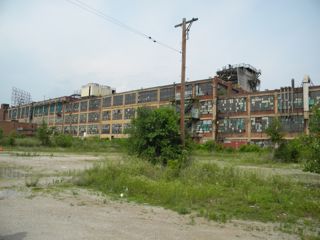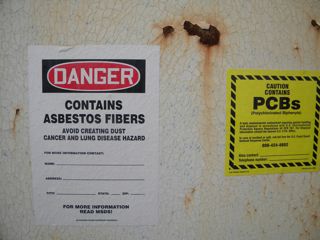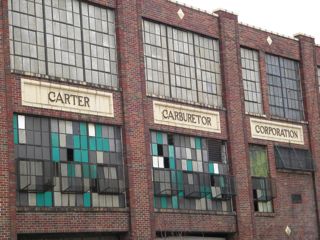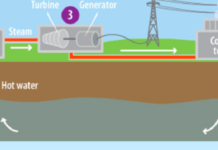This is a special SciJourner investigative report written by Marquise Middleton with additional help from Toni Stovall.
Carter Carburetor, once one of the largest job providers in north St. Louis, is now one of the most toxic

“The building has decreased the value of the community and also has potential health implications,” Romona Taylor-Williams, community member and Executive Director of the environmental group Metro St. Louis Coalition for Inclusion and Equality (M-SLICE), tells SciJourner.
“Since the [Carter Carburetor] building has been closed down, the entire [nearby] north Grand Boulevard area has declined,” says Marva Stovall, a former area resident and one-time employee at Carter. “They have closed and torn down the majority of the buildings around the plant. One major building gets closed down and the other little businesses follow.
Now, Carter Carburetor and the surrounding area are going to be cleaned up under Superfund, which is a federal government program to clean up the nation’s uncontrolled hazardous waste sites. The U.S. Environmental Protection Agency (EPA) plans to spend around $27 million to clean it up, but community activists and the EPA disagree on the chosen method for cleaning the site. There is also controversy about the future plans of the site once cleaned.
According to the EPA, the Carter building has unacceptably high levels of polychlorinated biphenyls (PCBs), trichloroethylene (TCE), and asbestos. PCBs are toxins that cause cancer while TCE is a heavy colorless toxin that causes liver and lung damage and is a probably cancer-causing chemical. Both chemicals were used at the Carter Plant as industrial lubricants. If the contaminates are not cleaned up they will spread through the soil and water.

Much of the pollution is on the surfaces. According to Janette Lambert, community involvement coordinator for the EPA, the clean up goal is 10 micrograms per 100 square centimeters, as measured with wipe samples or 1 milligram per kilogram, as measured by concrete core samples or brick chip samples. Measurements in the building are as high as 343 micrograms per 100 square centimeters and 52,000 milligrams per kilogram.
In addition, according to the EPA, the normal allowable level of PCB in soil is 50 parts-per-million (ppm). Carter Carburetor has levels as high as 858 ppm.
The EPA plans to demolish and remove the main Carter Carburetor building, and clean up another nearby less-polluted and smaller warehouse building known as the Willco Building.
However the controversy is about cleaning up the die cast area and an above ground tank storage. The plan for these two areas is to heat the soil to 600 ºF, and vacuum away hazardous chemicals. This method is called in situ thermal desportion and uses Massachusetts-based TerraTherm technology. The procedure will cost roughly $27 million.
According to Lambert, the treatment for the die cast area alone is expected to take two years.
Flint Fowler, President of the North Grand Boulevard Herbert Hoover Boys and Girls Club, which stands directly across from the abandoned factory, agrees that the site is dangerous, but he also thinks it is fixable. “Oh, I love [EPA’s plan] because it gets to where I think it needs to go,” Fowler tells SciJourner.
However, others warn that the method has risks. Taylor-Williams fears that when PCBs are heated to over 600 ºF, the possibility of them converting to dioxins escalates tremendously. According to World Health Organization website, dioxins are a group of chemically related compounds that are persistent Environmental Pollutants.
“I don’t like the idea of my community being used as a laboratory,” says Taylor.
Stephen Lester, science director at Center for Health, Environment & Justice (CHEJ), shares Taylor-William’s concern. According to their website, CHEJ protects communities from exposure to dangerous environmental chemicals.
“There are, I think, a lot of questions that haven’t been answered yet, and the EPA has not been very good about addressing these questions,” Lester warns.
According to Lester, the last full scale test for this TerraTherm technology was in 1997 and 1998 in Ferndale, CA at the Naval Facility Centerville Beach. The size of this treatment area was only 1200 square feet, while a 1997 full-scale test in Saipan, one of the Northern Mariana Islands in the Western Pacific, covered 20,000 square feet.
At risk is the future of the neighborhood. Carter Carburetor today is surrounded by dilapidated houses, closed stores and other eyesores. According to the 2000 Census, a mostly African American community surrounds Carter Carburetor.
“In the 1970’s, the whole north Grand boulevard area business flourished,” recalls Stoval. “The north Grand boulevard area had more houses. The bank over there was really populated, there actually was a restaurant that used to be over there, there was just a lot more business going on.”
According to nearby residents Earnest and Maggie Clark of North City, the neighborhood’s dilapidated houses and lack of cleanup efforts decrease the value of the community, making citizens want to move away.
“[The city] don’t do nothing to help this community,” say the Clarks.
“People still go onto the Carter Carburetor site despite the danger signs and health warnings,” says Stovall. “People actually use the site as a parking lot.”
Carter Carburetor owner Tom Kerr would like to see the site converted to a food pantry. Fowler says that he would not mind if the building was converted to something useful for the kids at Herbert Hoover Boys and Girls Club, such as an additional football field.
Several efforts by SciJourner to reach local alderman Freeman Bosley for a comment were unanswered.
The EPA has not yet begun working on the site and they do not yet know when they will begin. The EPA is negotiating the cleanup, cost, and future of the site with the potentially responsible parties but has not yet come up with a deal.
A long history

- Carter Carburetor manufactured carburetors at the site from 1930 until 1984 when the plant was closed.
- In April 1985 the land was deeded to the land reutilization authority (LRA). On the same date, LRA deeded the site to Hubert and Sharon Thompson.
- In 1986 Thompson sold the northeastern portion of Carter Carburetor to Edward Pivirotto and his wife. The Pivirottos subsequently failed to pay real estate taxes on the portion of the building they owned. It is now again owned by LRA.
- In August 1987, The U.S. EPA conducted a Toxic Substances Control Act (TSCA) inspection of the facility.
- In 1988 Thompson contracted with an environmental contractor to clean up and remove the PCB materials and/or PCB-Contaminated transformers.
- In 1991, Thompson told EPA that there were no more funds for cleanup.
- In the summer of 2006, ACF—the corporation that owned Carter Carburetor—contracted for environmental assessments for lead-based paint, asbestos, PCBs, and TCE. The results of this investigation confirmed and further described PCBs in the CBI building, as well as lead paint in the CBI and Wilco buildings. The contractors also identified the presence of relatively high levels of TCE in sub-surfaced soils beneath the location TCE storage tank.
- In 2007 ACF conducted a further investigation for TCE in subsurface soil; ACF’s contractors investigated and cleaned up all accessible sewer lines.
- In 2008 the EPA conducted an on-site vapor intrusion study by collecting samples right beneath the building floors and other concrete slabs at the site. The result of this study proved that TCE vapors were present beneath the buildings.
- On August 10, 2011, EPA announced that the contamination from the site had not spread to the surrounding neighborhood and posed no health risk.
- Currently, Tom Kerr owns and is the responsible party for Carter Carburetor.

This work is licensed under a Creative Commons Attribution-NonCommercial-NoDerivs 3.0 Unported License














Marquise, I’m so proud of you for sticking it out to finish this article well! You addressed stakeholders on all sides of the issue, explained the science clearly, and brought light to a situation that would have been left in the dark for most of our readers if you didn’t cover it. Thanks for doing such excellent work!
Wow finally got published feels good! Took me all summer to complete thanks for all the help scijourn couldn’t of done it with out you guys.
HP has revolutionized the concept of laptop. Armed with the latest updated processors operating system and stunning finishes really HP is going gaga.
Itâ:-??s the musical concert live home that is now at your fingertips. Your musical taste is treated even with better treatment, in the form of music players. Itâ:-??s the expedition of music playing gadgets that RightShopping.in studs.
Gifts are your ambassadors to your acquaintances, especially when you are away from them. Your gift keeps telling them the quality term they with you, and your gift lets them realize that you are a part of their celebration as well. Cruise onto http://www.hampersnationwide.com/Germany/Send_Gifts_to_Germany.asp for more details.
Keep up the good work. Best of luck. From http://www.gifts2hongkong.com
Your gifts bring the sudden happiness to your loved ones. Time may pass on, but your gifts will keep making them happy, even when there is no specific reason. Thatâ:-??s the wonder touch gifts do give to life. Visit http://www.hampersnationwide.com/USA/Send_Gifts_to_USA.asp for more details.
this was a very good article i like how you explained the topic clearly thanks for doing a good job
thanks for makink this acticle
My father worked there for over 25 years. I now realize why he had COPD after breathing all of those fumes from the Die cast department. Makes me sad but I am glad they are getting rid of the toxic site.